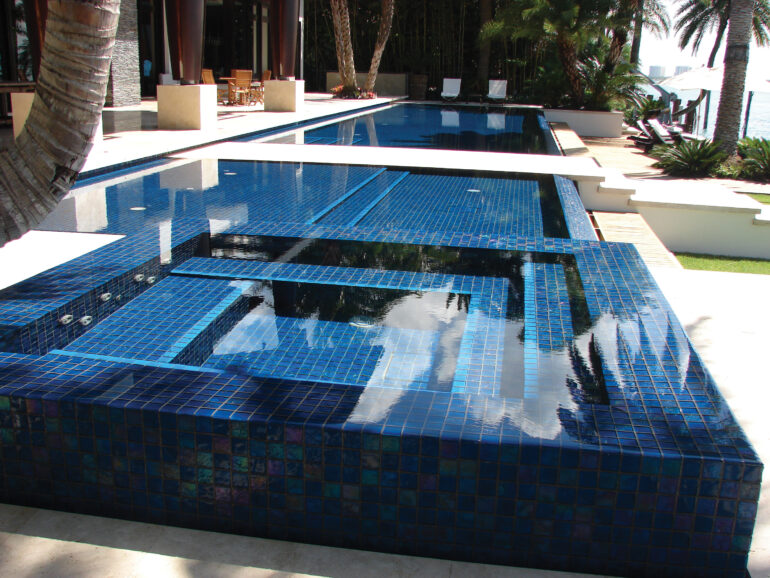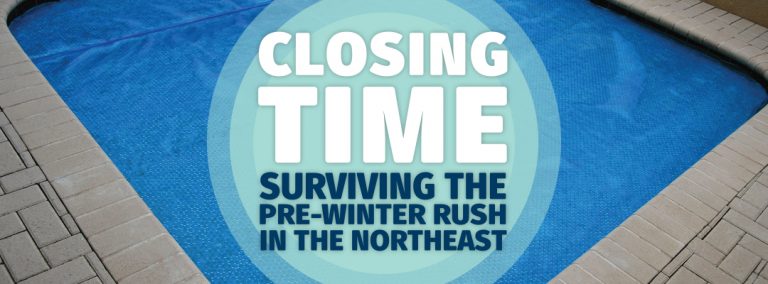Checklist Champ

Are you feeling haunted by your preseason checklist? Don’t leave it looming until the last minute. Avoid burnout and confidently head into peak season with strategies to tackle your tasks like a champ.
For Austin Gardiner, CEO of GL Pools in San Diego, California, a proactive approach and an early start on to-do lists makes the swim season more enjoyable for all.
“Pool pros can underestimate the demand of the swim season,” he says. “We need to predict and prepare for the highest levels of usage and not be caught off guard.”
Kyle Peter, owner of Nevergreen Pools in Shingle Springs, California, says pool pros can trip themselves up when they’re too laid back about their preseason timeframe. “If you don’t plan ahead — if you treat March like January and February — you’re going to get behind the eight ball in April and May, and then you’re running into Memorial Day,” Peter says. “That’s where I see the biggest mistakes.”
Since things rarely go exactly as planned, focus on improving efficiency in routing, invest in training to save time on the job and set clear expectations with customers about potential challenges. Maintaining strong communication with both your team and customers is crucial for a smooth and successful season.
Pitfalls to avoid
Ernie Civic, owner of Civic’s Pool Service in Tampa, Florida, says one of the most frequent pitfalls he’s seen is pool pros showing up to a job with broken or run-down equipment.
“This not only delays service but also creates a poor impression with clients,” Civic says. “We ensure every piece of equipment is inspected, repaired or replaced before the season starts, so we’re fully prepared for every service call.”
Civic notes that neglecting to test and balance pool water before the season can lead to algae growth, equipment damage and unhappy customers. Prioritizing water chemistry at opening ensures pools start off clear and balanced.
Another pitfall Civic sees is a lack of preseason training for employees that often results in inefficiencies and mistakes, especially when troubleshooting equipment or handling client concerns. “We invest in training our team on the latest tools, techniques and customer service skills to ensure they’re confident and capable during the busy season,” he says.
If you don’t plan ahead, if you treat March like January and February, you’re going to get behind the eight ball in April, May, and then you’re running into Memorial Day. That’s where I see the biggest mistakes.”
Kyle Peter, Nevergreen Pools
Civic says another missed opportunity is failing to educate clients about upgrades, seasonal needs or preseason checks. Pool pros can engage with clients through newsletters, maintenance reports and one-on-one consultations to ensure they’re empowered to make the best decisions for their pools.
“Our mantra is simple: Check twice, fix once,” Civic says.
Michael Ellison, owner of Cool Haven Pool Repair in Forney, Texas, advises pool pros to work on routing efficiency, with lots of training to save time on the job. Additionally, he says failing to ask customers clarifying questions can set incorrect expectations.
“I ask many questions to find out what’s most important to [the customer],” Ellison says.
Questions about efficiency, price, durability, warranty, convenience and residency timeframe can be helpful.
“I try to always set them up with a piece of equipment that will suit them for the growing technology and future automation,” Ellison says.
He advises limiting options to save time and giving a truthful perspective when asked. “I only give them one to two options and no more,” he says. “If they ask my opinion, I will give my honest opinion as if I were in their shoes.”
Checklist must-haves
A process for taking notes
Peter says it’s easy to forget how hectic an unexpected challenge was during the busy season, so his team takes notes when they happen, and then those notes are revisited during the offseason when systems can be put in place to prevent or lessen similar issues in the future.
“We’ve learned the hard way that making major changes midsummer just isn’t practical,” Peter explains.
In past winters, Peter’s team tackled key operational improvements, including implementing an inventory tracking app that maintains stock levels and automatically generates supplier orders daily to prevent shortages. The company also streamlined IT operations by moving more than 20 iPhones into Apple Business Manager and Mosyle, eliminating the need for individual Apple IDs and saving countless hours of troubleshooting.
“Each October, we pull out the winter project list, rank items by priority and impact and get to work,” Peter says, noting other projects like SOP updates, a billing system overhaul and implementation of a CRM. “It’s a game-changer for keeping our operations running smoothly.”
Equipment and pool inspections
Gardiner, Peter and Civic agree that all equipment, especially pieces that will be heavily used, should be inspected and tested during preseason.
“We often think of these spring season checks as a soft-open where we want to catch and diagnose any point of failure before the season with the highest demand and expectation,” Gardiner says.
Civic says key pool components to inspect include:
- Pumps and motors: Check for noise, leaks and efficiency. Red flags: Excessive noise, low pressure or visible leaks
- Filters: Inspect for cracks, clogs or signs of wear. Clean or replace filter media if needed. Red flags: Cracks, clogs or pressure consistently above normal
- Heaters: Test ignition, flow sensors and thermostats to ensure proper heating. Red flags: Inconsistent heating or failure to ignite
- Plumbing and valves: Look for leaks, cracks or corrosion in pipes and fittings. Red flags: Water loss, air bubbles in returns or corroded fittings
- Electrical components: Test control panels, timers and lights. Red flags: Malfunctioning controls, buttons or lighting
Automate where you can
Peter’s team implements annual or biannual services that are locked in, like filter cleanings. He suggests automating existing services to ensure proactive maintenance year-round.
“We do that maintenance when it’s getting more heavily used, and we preemptively replace parts that are worn,” he explains. “It’s nice offseason revenue for us.”
Peter says there may be some delayed maintenance when something’s not working and the customer isn’t ready financially to address it. His team reaches out in spring instead of waiting for their call in June, helping to spread out the workflow.
Apps and management software streamline and automate service routes, chemical and inventory management, customer care and communication, work schedules and more. Software can also provide insight about the previous year’s needs, so you can plan for what’s needed and when.
Peter, Civic and Gardiner recommend Hubspot for client management and marketing, the Orenda app for dosing and calculating chemicals, the Skimmer app for route tracking and overall client care and Orca Scan, which manages costs, manufacturer and supplier info, part numbers, related data and provides a barcode scanner. Gardiner says service software is valuable, both for recordkeeping and communication your clients can receive through photos and custom messages.
“Set aside time before summer to move away from a binder with papers or a mind packed full of best-guess memories on prior dosages,” Gardiner suggests. “You and your clients will thank you for it.”
Consider regional weather conditions
Weather influences the kind of wear on equipment and the level of chemical use. Pool pros should assess the seasonal weather their clients’ pools will endure to plan on chemical inventory and areas of the pool that may need more inspection and attention.
Gardiner says their area of San Diego is classified as a coastal desert, with Santa Ana winds and above-average evaporation rates that affect pool water levels and puts the client at risk of swimming in suboptimal water.
Civic says his team’s checklist addresses challenges related to Florida’s heat and frequent rain. “By tailoring our approach to Florida’s climate, we ensure pools remain safe, balanced and ready for the season,” he says.
Embrace rest and recharging
Gardiner says preseason is the time to squeeze in some self-care, and if you’re able to travel or unplug on vacation, make time for it.
“Be fresh,” he advises. “Get some time away if you can arrange it. Take care of your body and mind. If you have a nagging injury, seek some answers. Embrace self-care so that you can show up as the best version of yourself for your clients and those around you.”
Gardiner also says this is the time for pool pros to address feelings of imposter syndrome by filling any knowledge gaps.
“Become a true subject matter expert on at least one element in this profession,” he says. “This will revitalize your passion for your work and offer a new perspective.”
Gardiner points out that any knowledge and expertise gained also provides added value to clients — a win-win.
He also suggests promoting time off to your team, so everyone has energy heading into the demanding season.
“Have a fully staffed team that can cover for those who get sick or injured without overtaxing the faithful and reliable team members who are showing up daily,” Gardiner advises. “Motivate your staff by making sure they see the beauty and meaning in their work.”
Leaning into training and preparation will ensure team members have everything they need to give their best during the swim season.
“We want our team to understand how valuable their contribution is to our community through their expertise and hard work,” Gardiner says. “We are helping people truly enjoy life and keeping them safe.”






